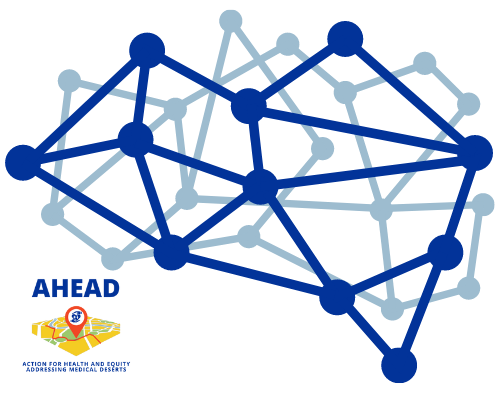What are medical deserts?
In the initial stages of the AHEAD project, we carried out a literature review to better define the concept of ‘medical desertification’. Based on a thorough review of scientific studies, we have concluded that the complex concept requires a set of definitions to understand its multidimensional perspective. From the literature review, we derived a working definition to inform the development of research tools and validated this definition through the results of research tools.
Below is our final working definition of medical desertification.
Definition
Short definition
A medical desert is the end point of a complex process called ‘medical desertification’, that implies continuous and increasing inability of a given population to access health services in a timely and contextually relevant manner.
Further explanation
The regions likely at risk of becoming a medical desert can be identified and based on the factors commonly used for describing the three dimensions of access to health care, and could be categorized as barriers.
Specific definitions of the terms used:
Context: the context entails the local, regional and national levels, which should be investigated based on the available standards and (social) norms.
Given population: a population in a specific area (e.g. municipality; region) or isolated area (e.g. hard to reach, rural locations) or population groups with specific needs and/or vulnerabilities (e.g. Roma, migrants, the elderly).
Dimensions: the physical access, social and policy dimensions are interrelated and dependent on each other in varying degrees and modalities.
Factors: each dimension can be investigated by a range of factors, such as (see below – not an exhaustive list):
Physical access factors
- Availability of (1) general-practitioner, (2) community health centers, (3) emergency services, (4) hospitals, (5) pharmacists
- Distance to primary healthcare facilities
- Average time to reach the health facility or the patient, using the emergency services.
Social factors
- Cultural sensitivity and context-appropriateness of the care that is being offered
- Expectations of the population (e.g. supply vs. demand, met vs. unmet needs, and expectation of the population on isolation based on location, are among the factors to be considered during investigation).
Policy factors
- Regional and rural development strategies
- Human resources for health strategies – policy decisions on the availability and distribution of primary health care personnel; renumeration methods; regulation, including strategies for licensing and continuous professional development
- Strategies for primary health care facilities and their management
- Strategies for specialist services (such as distribution of specialised hospitals, services provided, etc.).
- Cost of services to the patient and financing the health system.
The factors can be identified using qualitative and quantitative research tools. These tools are a guideline of the approach and should be contextualised to each research objective.
The quantitative factors should result in a database that can be used to compute a medical desertification index (see below), which provides an insight into whether this area is at risk of becoming a medical desert.
The qualitative factors should be used to further understand the realities of potential medical deserts.
Medical desertification index
A research team can decide to adapt the research and index calculation methodology to the specific objective and context.
The index provides a snapshot of the situation, and thus must be investigated further and analysed over time to definitively conclude whether the area is indeed going through desertification or has reached the end of the process.
Once the key factors are investigated, understood (and compared to national standards) and where possible, computed into a set of indexes, one can make a conclusion on the stage of the process of medical desertification.






